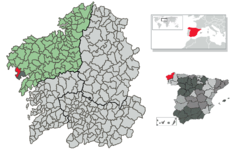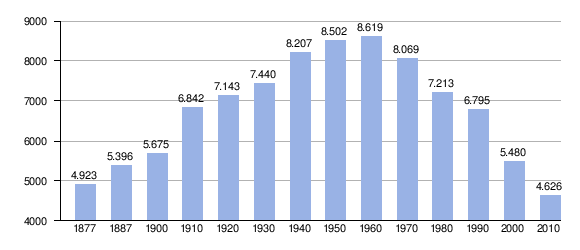Carnota (Galicia)
| Carnota parish | ||
|---|---|---|

Hórreo de Carnota. In the background the tower of the parish church of Santa Comba .
|
||
| coat of arms | Map of Spain | |

|
|
|
| Basic data | ||
| Autonomous Community : |
|
|
| Province : | A Coruña | |
| Comarca : | Muros (Comarca) | |
| Coordinates | 42 ° 49 ′ N , 9 ° 6 ′ W | |
| Area : | 70.9 km² | |
| Residents : | 3,957 (Jan 1, 2019) | |
| Population density : | 55.81 inhabitants / km² | |
| Postal code : | 15293 | |
| Municipality number ( INE ): | 15020 | |
| Nearest airport : | Santiago de Compostela | |
| administration | ||
| Official language : | Castilian , Galician | |
| Mayor : | Ramón Noceda ( BNG ) | |
| Address of the municipal administration: | Pza. San Gregorio, 19 - 15293 - Carnota - A Coruña - Tel .: +34 981 857 032 | |
| Website : | concellodecarnota.com | |
| Location of the municipality | ||

|
||
Carnota is a municipality on the west coast of Galicia . In the municipality lies Praia de Carnota , the longest beach in Galicia.
history
Several petroglyphs have been preserved from prehistoric times . They were discovered in 1980 by a group of schoolchildren on the Höhenweg above the sports hall.
In the Celtic era there were several castros in the area . The best preserved is the Castro de Mallou , of which the foundations of some buildings can still be seen. The round structure of the fortified settlement has continued into the current development. The round shape of a former Castro can also be seen in the Parroquia Lira .
At the place Penafiel there was probably a Celtic cult site, which was desecrated by the Roman general Lucius Sestio. There was probably a tin mine near the village of Chan de Lamas. The tin was sold to the Phoenicians.
Community structure
Carnota consists of the following parroquias :
- Lariño (San Martiño)
- Lira (Santa María)
- O Pindo (San Clemente)
- San Mamede de Carnota (San Mamede)
- Santa Comba de Carnota (Santa Comba o Columba)
politics
| Political party | 2015 | 2011 | ||
|---|---|---|---|---|
| Be right % | Seats | Be right % | Seats | |
| PP | 31.28% | 3 | 44.49% | 5 |
| BNG | 48.31% | 6th | 33.48% | 4th |
| PSOE | 18.17% | 2 | 20.45% | 2 |
economy
| Employees | Percentage | ||||
|---|---|---|---|---|---|
| TOTAL | 1,070 | 100 | |||
| Agriculture, livestock and fishing | 174 | 16.26 | |||
| Industry | 152 | 14.21 | |||
| Construction industry | 129 | 12.06 | |||
| Service companies | 615 | 57.48 | |||
| * Data from the Statistical Office for Economic Development in Galicia , IPI | |||||
Population development of the municipality
Attractions
Hórreos
Carnota is best known for its Hórreo , a Spanish national monument. This Hórreo de Carnota was started in 1768 and reached its current size in 1783. It is made entirely of granite and has a length of 34.76 m. It is known as the largest Hórreo in Galicia, but the Hórreo in the Parroquia Lira may be a few inches longer. Built between 1779 and 1814, and with a similar equipment, the latter testifies to the former rivalry between the two communities. However, it is less well preserved than the Hórreo de Carnota .
Churches
- The parish church of Santa Comba Carnota was built from 1775 in the classicist Baroque style. The floor plan combines the shape of a Latin cross with that of a three-aisled basilica . The tall bell tower was built in the 19th century. The altarpiece inside is the work of the master Gambino Ferreiro.
- The simple chapel of San Gregorio , built in 1600, is located near the town hall .
- The parish church in Lira, built in 1760 and heavily rebuilt in 1825, also has an impressive bell tower. Also in Lira, the Virxe dos Remedios chapel bears witness to the worship of fishermen for their patron saint, the Blessed Virgin of Salvation .
Coastal landscape
The 42 kilometer long coastline of the municipality offers a total of 33 beaches and a number of natural attractions.
- Carnota Beach, 7 km long, is shaped like a crescent moon. It is lined with dunes, swamps and an inner lagoon. The landscape is home to diverse plant and animal communities. It is one of the few breeding areas of the ringed plover in Galicia. Bird lovers can spot many more species of migratory and stationary birds. In the northern third, the mouth of the Vadebois stream forms varied structures.
- The quiet Praia Insuela lies partly in the territory of the municipality of Caldebarcos .
- Boca do Rio beach offers varied paths for hiking.
- The sheltered beach of Quilmas was once the landing place for Norman boats and pirate ships.
- The beach of Lariño, exposed to the Atlantic Ocean, offers surfers and bodyboarders a strong surf. The decommissioned Lariño lighthouse is falling into disrepair. A citizens' initiative is committed to ensuring that it is preserved.
- The Praia o Pindo , including Praia de San Pedro called, is sheltered at the foot of Mount Pindo.
Festivals
- Carnota celebrates the carnival extensively before the start of Lent . One celebrates with rich meals, in which a lot of pork and delicious desserts are consumed. The streets are filled with masked people. You make fun of the upper social classes, the powerful and the institutions. A straw doll named Entruido or Nicolas embodies the carnival. It is carried around in processions during the three days and burned at the end. The traditional festival ends with a speech in the main square of the community, in which events of the past 12 months are reviewed.
- The festival of San Xoán takes place at the summer solstice. The sun plays a fundamental role. You dance into the sunset or, according to a popular belief, in the sky. In addition to the sun, water is a key element of the celebration. On the evening before, June 23rd, the residents left the village, armed with containers full of water and aromatic herbs and fruits such as St. John's wort, fennel, lemon and rosemary. The smell is said to drive away evil. The residents of the community meet around the campfire to cultivate neighborly relations over grilled sardines and wine. After the celebration, the young people stage the attack of evil by creating disorder: for example, they kidnap the neighbor's car, board up their doors so that they cannot leave the house, disguise the company notices. The next morning the water is used to purify the soul and protect the body from diseases.
- The various churches each celebrate a festival in honor of their patron saint.
Individual evidence
- ↑ Cifras oficiales de población resultantes de la revisión del Padrón municipal a 1 de enero . Population statistics from the Instituto Nacional de Estadística (population update).
- ↑ a b c d e f g Historia e Patrimonio ( Memento of the original dated February 4, 2015 in the Internet Archive ) Info: The archive link was inserted automatically and has not yet been checked. Please check the original and archive link according to the instructions and then remove this notice. , Website of the municipality, accessed on February 13, 2015
- ↑ 2015 Spanish Ministry of the Interior ( page no longer available , search in web archives ) Info: The link was automatically marked as defective. Please check the link according to the instructions and then remove this notice.
- ↑ 2011 Spanish Ministry of the Interior
- ↑ Unless other sources are expressly mentioned, this section is based on Praias e Areais ( Memento of the original dated February 4, 2015 in the Internet Archive ) Info: The archive link was inserted automatically and has not yet been checked. Please check the original and archive link according to the instructions and then remove this notice. , Website of the municipality, accessed on February 13, 2015
- ↑ Salvemos o faro de Lariño , blog of the citizens' initiative, accessed on February 13, 2015
- ↑ a b c Festas Populares ( Memento of the original dated February 4, 2015 in the Internet Archive ) Info: The archive link was inserted automatically and has not yet been checked. Please check the original and archive link according to the instructions and then remove this notice. , Website of the municipality, accessed on February 13, 2015




